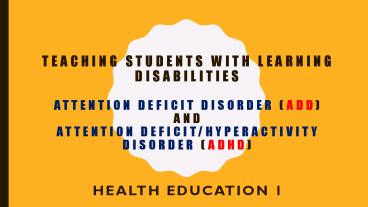Teaching Students With Learning Disabilities ADD/ADHD PowerPoint PPT Presentation
Title: Teaching Students With Learning Disabilities ADD/ADHD
1
Teaching Students with Learning
DisabilitiesAttention Deficit Disorder (ADD)
and Attention Deficit/Hyperactivity Disorder
(ADHD)
- HEALTH EDUCATION 1
2
Special education experts highly recommend the
use of diagnostic-prescriptive-evaluation
approach in teaching children with learning
disabilities as well as those with mental
retardation.
3
Here, the result of assessment are used directly
to draw up an individualized education plan. The
long term annual goals that the student can
achieve are identified, then the short-term
quarterly objectives are prescribed.
4
Monthly, weekly, and daily instructional plans
are written to achieve the pre-set goals and
objectives of teaching. Formative and summative
evaluation procedures are employed to track the
mastery of the skills.
5
Attention Deficit Disorder (ADD) and Attention
Deficit/Hyperactivity Disorder (ADHD) Attention
Deficit Disorder (ADD) and Attention
Deficit/Hyperactivity Disorder ADHD) are
conditions in which children exhibit significant
differences in the ability to pay attention and
to engage in active work compared to their normal
peers.
6
These children show lack of control in saying
things, cannot wait for their turn and often
engage in dangerous activities. ADD and ADHD are
common characteristics of children with learning
disabilities.
7
There is attention deficit when the child is not
able to attend a task expected of his or her age
and grade level. Hyperactivity is present when
the child engages in high rates of purposeless
movement. Impulsivity is displayed through
inappropriate behavior.
8
The essential feature of ADD/ADHD is a persistent
pattern of a combination of inattention,
hyperactivity and impulsivity that is more
frequent and severe, maladaptive and inconsistent
with the developmental level of the child.
9
The Diagnostic and Statistical Manual on Mental
Disorders IV of the American Psychiatric
Association DSM IV, APA gives the symptoms and
states that either 1 or 2 are present.
10
- Six or more of the following eight symptoms of
inattention have persisted for at least six
months - a. Often fails to give close attention to details
or makes careless mistakes in schoolwork, work or
other activities. - b. Often has difficulty sustaining attention in
tasks or play activities.
11
c. Often does not follow through on instructions
and fails to finish schoolwork, choices or duties
in the workplace. d. Often has difficulty
organizing tasks and activities.
12
e.Often avoids dislikes or is reluctant to engage
in tasks that require sustained mental effort
such as schoolwork or homework. f. Often loses
things necessary for tasks or activities such as
toys, school assignments, pencils, books, or
tools.
13
g. Is often easily distracted by extraneous
stimuli. h. Is often forgetful in daily
activities.
14
- Six or more of the eight symptoms of
hyperactivity-impulsivity hyperactivity - a. Often fidgets with hands or feet or squirms in
seat. - b. Often leaves seat in classroom or in other
situation in which remaining seated is expected.
15
c. Often runs about or climbs excessively in
situations in which it is inappropriate. In
adolescents and adults this is an expressions of
subjective feelings of restlessness. d. Often has
difficulty playing or engaging in leisure
activities quietly. e. Is often on the go or
often acts as if driven by a motor.
16
Impulsivity a. Often blurts out answers before
questions have been completed. b. Often has
difficulty in waiting turn. c. Often interrupts
or intrude on others, butts into conversations or
games. Some symptoms are present before age 7.
17
The ADD/ADHD Iceberg ADD/ADHD is a complex
condition. The condition may range from mild,
moderate, severe to profound and may exist
together with other disabilities.
18
While there are observable symptoms and
characteristics, many of the signs are not
visible. Compared to an iceberg where only
one-eight can be seen in the surface of the
ocean, most of the symptoms and characteristics
are not observable and remain hidden in the
persons behavior.
19
(No Transcript)
20
Thank you for listening
- Discussant Sheryll C. Salindo

